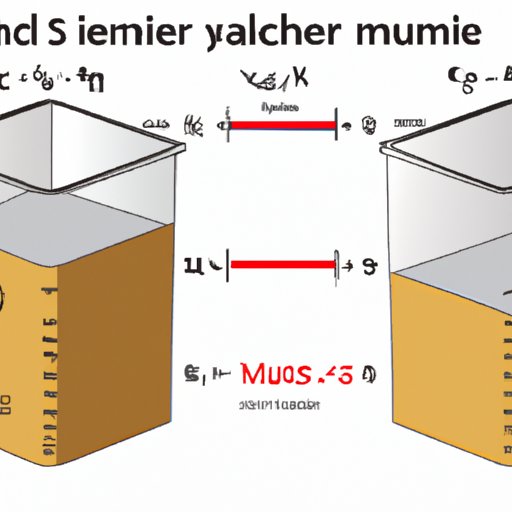Introduction
Being able to calculate volume using density and mass is an important skill in many fields, including chemistry, physics, and engineering. Understanding this relationship between density, mass, and volume can help you solve a wide range of problems, from calculating the concentration of a solution to determining the weight of an object. In this article, we will provide a comprehensive guide to mastering the art of finding volume with density and mass.
Understanding the Relationship between Density, Mass, and Volume
Density is a measure of how much mass is contained within a given volume. Mass refers to the amount of matter in an object, while volume is the amount of space that object takes up. These properties are related to each other in a simple equation:
Density = Mass / Volume
This means that if you know the mass and density of an object, you can calculate its volume by rearranging the equation:
Volume = Mass / Density
For example, if you have a cube of gold with a mass of 100 grams and a density of 19.3 g/cm³, you can calculate its volume as follows:
Volume = Mass / Density = 100 g / 19.3 g/cm³ = 5.18 cm³
The Ultimate Guide to Calculating Volume Using Density and Mass
Let’s take a closer look at the formula for finding volume using density and mass:
Volume = Mass / Density
When solving a problem using this formula, it is important to make sure that the units you are working with are consistent. For example, if the mass of an object is given in kilograms and the density is given in grams per cubic centimeter, you will need to convert one of these units so that they are both expressed in the same system.
To use the formula, simply plug in the values you have for mass and density and do the math:
Example problem: A piece of metal has a mass of 200 grams and a density of 7.8 g/cm³. What is its volume?
Solution:
Volume = Mass / Density = 200 g / 7.8 g/cm³ = 25.6 cm³
Therefore, the volume of the metal is 25.6 cubic centimeters.
When using the formula, be sure to keep track of significant figures and round off the final answer to the appropriate number of decimal places. In addition, double-check your work to make sure that your answer is reasonable and makes sense in the context of the problem.
Mastering the Art of Finding Volume with Density and Mass
Calculating volume with density and mass can be a bit tricky, especially if you are working with unusual shapes or materials. Here are some strategies for increasing your accuracy:
- Be sure to measure the mass and density of the object as accurately as possible using high-quality instruments.
- Use the appropriate formula for the shape of the object you are working with (e.g. the formula for the volume of a cylinder is different from the formula for the volume of a sphere).
- If you are working with an object with an irregular shape, try submerging it in water and measuring the volume of water that is displaced. The volume of the object is equal to the volume of the water it pushes aside.
- If you are working with a mixture of substances with different densities, use the formula for weighted averages to find the overall density of the mixture before solving for volume.
Remember, practice makes perfect! The more you work with this formula, the easier it will become.
Step-by-Step Instructions: How to Find Volume Using Density and Mass
Here is a step-by-step guide to help you find the volume of any object using density and mass:
- Determine the mass of the object using a scale or balance.
- Determine the density of the object by consulting a reference book or performing your own measurements.
- Plug in your values for mass and density into the formula Volume = Mass / Density.
- Do the math to solve for volume.
- Double-check your work and make sure your answer is reasonable.
Remember to keep track of units and significant figures throughout the calculation.
Top Tips for Accurately Calculating Volume with Density and Mass
Here are some additional tips and tricks to help you become a master at calculating volume with density and mass:
- Use the appropriate formula for the shape of the object you are working with.
- If you are working with a mixture of substances with different densities, use the formula for weighted averages to find the overall density of the mixture.
- If you are working with an object with an irregular shape, try submerging it in water and measuring the volume of water that is displaced. The volume of the object is equal to the volume of the water it pushes aside.
- When measuring density, use high-quality instruments and take multiple measurements to ensure accuracy.
- Work with a partner or tutor to get feedback and learn from your mistakes.
Conclusion
Calculating volume using density and mass is an essential skill in many fields, from science and engineering to cooking and brewing. By understanding the relationship between these properties and using the appropriate formulas and strategies, anyone can become proficient at finding volume with density and mass.
